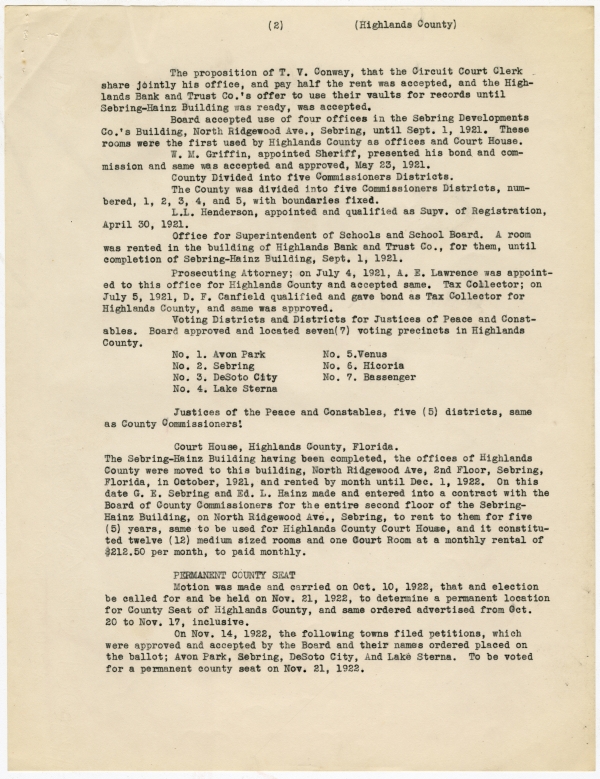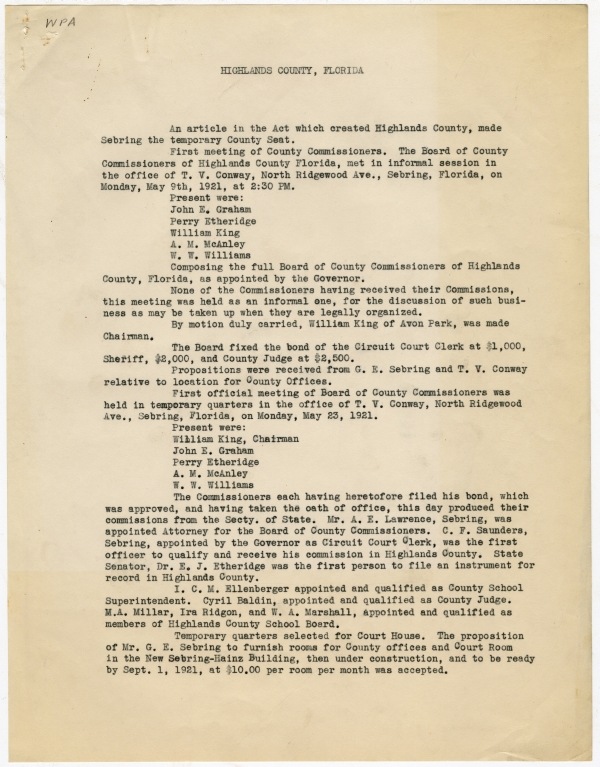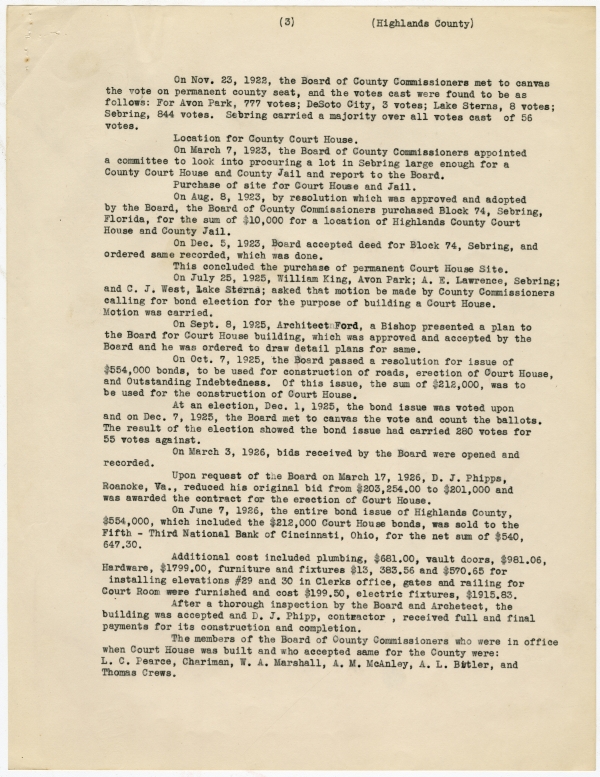WPA
HIGHLANDS COUNTY, FLORIDA
An article in the Act which created Highlands County, made Sebring the temporary County Seat.
First meeting of County Commissioners. The Board of County Commissioners of Highlands County Florida, met in informal session in the office of T. V. Conway, North Ridgewood Ave., Sebring, Florida, on Monday, May 9th, 1921, at 2:30 PM.
Present were:
John E. Graham
Perry Etheridge
William King
A. M. McAnley
W. W. Williams
Composing the full Board of County Commissioners of Highlands County, Florida, as appointed by the Governor.
None of the Commissioners having received their Commissions, this meeting was held as an informal one, for the discussion of such business as may be taken up when they are legally organized.
By motion duly carried, William King of Avon Park, was made Chairman.
The Board fixed the bond of the Circuit Court Clerk at $1,000, Sheriff, $2,000, and County Judge at $2,500.
Propositions were received from G. E. Sebring and T. V. Conway relative to location for County Offices.
First official meeting of Board of County Commissioners was held in temporary quarters in the office of T. V. Conway, North Ridgewood Ave., Sebring, Florida, on Monday, May 23, 1921.
Present were:
William King, Chairman
John E. Graham
Perry Etheridge
A. M. McAnley
W. W. Williams
The Commissioners each having heretofore filed his bond, which was approved, and having taken the oath of office, this day produced their commissions from the Secty. of State. Mr. A. E. Lawrence, Sebring, was appointed Attorney for the Board of County Commissioners. C. F. Saunders, Sebring, appointed by the Governor as Circuit Court Clerk, was the first officer to qualify and receive his commission in Highlands County. State Senator, Dr. E. J. Etheridge was the first person to file an instrument for record in Highlands County.
I. C. M. Ellenberger appointed and qualified as County School Superintendent. Cyril Baldin, appointed and qualified as County Judge. M. A. Millar, Ira Ridgon, and W. A. Marshall, appointed and qualified as members of Highlands County School Board.
Temporary quarters selected for Court House. The proposition of Mr. G. E. Sebring to furnish rooms for County offices and Court Room in the New Sebring-Hainz Building, then under construction, and to be ready by Sept. 1, 1921, at $10.00 per room per month was accepted.
(2) (Highlands County)
The proposition of T. V. Conway, that the Circuit Court Clerk share jointly his office, and pay half the rent was accepted, and the Highlands Bank and Trust Co.'s offer to use their vaults for records until Sebring-Hainz Building was ready, was accepted.
Board accepted use of four offices in the Sebring Developments Co.'s Building, North Ridgewood Ave., Sebring, until Sept. 1, 1921. These rooms were the first used by Highlands County as offices and Court House.
W. M. Griffin, appointed Sheriff, presented his bond and commission and same was accepted and approved, May 23, 1921.
County Divided into five Commissioners Districts.
The County was divided into five Commissioners Districts, numbered, 1, 2, 3, 4, and 5, with boundaries fixed.
L. L. Henderson, appointed and qualified as Supv. of Registration, April 30, 1921.
Office for Superintendent of Schools and School Board. A room was rented in the building of Highlands Bank and Trust co., for them, until completion of Sebring-Hainz Building, Sept. 1, 1921.
Prosecuting Attorney; on July 4, 1921, A. E. Lawrence was appointed to this office for Highlands County and accepted same. Tax Collector; on July 5, 1921, D. F. Canfield qualified and gave bond as Tax Collector for Highlands County, and same was approved.
Voting Districts and Districts for Justices of Peace and Constables. Board approved and located seven(7) voting precincts in Highlands County.
No. 1. Avon Park
No. 2. Sebring
No. 3. DeSoto City
No. 4. Lake Sterna
No. 5. Venus
No. 6. Hicoria
No. 7. Bassenger
Justices of the Peace and Constables, five (5) districts, same as County Commissioners:
Court House, Highlands County, Florida.
The Sebring-Hainz Building having been completed, the offices of Highlands County were moved to this building, North Ridgewood Ave, 2nd Floor, Sebring, Florida, in October, 1921, and rented by month until Dec. 1, 1922. On this date G. E. Sebring and Ed. L. Hainz made and entered into a contract with the Board of County Commissioners for the entire second floor of the Sebring-Hainz Building, on North Ridgewood Ave., Sebring, to rent to them for five (5) years, same to be used for Highlands County Court House, and it constituted twelve (12) medium sized rooms and one Court Room at a monthly rental of $212.50 per month, to paid monthly.
PERMANENT COUNTY SEAT
Motion was made and carried on Oct. 10, 1922, that and [sic] election be called for and be held on Nov. 21, 1922, to determine a permanent location for County Seat of Highlands County, and same ordered advertised from Oct. 20 to Nov. 17, inclusive.
On Nov. 14, 1922, the following towns filed petitions, which were approved and accepted by the Board and their names ordered placed on the ballot; Avon Park, Sebring, DeSoto City, And [sic] Lake Sterna. To be voted for a permanent county seat on Nov. 21, 1922.
(3) (Highlands County)
On Nov. 23, 1922, the Board of County Commissioners met to canvas the vote on permanent county seat, and the votes cast were found to be as follows: For Avon Park, 777 votes; DeSoto City, 3 votes; Lake Sterns, 8 votes; Sebring, 844 votes. Sebring carried a majority over all votes cast of 56 votes.
Location for County Court House.
On March 7, 1923, the Board of County Commissioners appointed a committee to look into procuring a lot in Sebring large enough for a County Court House and County Jail and report to the Board.
Purchase of site for Court House and Jail.
On Aug. 8, 1923, by resolution which was approved and adopted by the Board, the Board of County Commissioners purchased Block 74, Sebring, Florida, for the sum of $10,000 for a location of Highlands County Court House and County Jail.
On Dec. 5, 1923, Board accepted deed for Block 74, Sebring, and ordered same recorded, which was done.
This concluded the purchase of permanent Court House Site.
On July 25, 1925, William King, Avon park; A. E. Lawrence, Sebring; and C. J. West, Lake Sterns; asked that motion be made by County Commissioners calling for bond election for the purpose of building a Court House. Motion was carried.
On Sept. 8, 1925, Architect Ford, a Bishop presented a plan to the Board for Court House building, which was approved and accepted by the Board and he was ordered to draw detail plans for same.
On Oct. 7, 1925, the Board passed a resolution for issue of $554,000 bonds, to be used for construction of roads, erection of Court House, and Outstanding Indebtedness. Of this issue, the sum of $212,000, was to be used for the construction of Court House.
At an election, Dec. 1, 1925, the bond issue was voted upon and on Dec. 7, 1925, the Board met to canvas the vote and count the ballots. The result of the election showed the bond issue had carried 280 votes for 55 votes against.
On March 3, 1926, bids received by the Board were opened and recorded.
Upon request of the Board on March 17, 1926, D. J. Phipps, Roanoke, Va., reduced his original bid from $203,254.00 to $201,000 and was awarded the contract for the erection of Court House.
On June 7, 1926, the entire bond issue of Highlands County, $554,000, which included the $212,000 Court House bonds, was sold to the Fifth - Third National Bank of Cincinnati, Ohio, for the net sum of $540,647.30.
Additional cost included plumbing, $681.00, vault doors, $981.06, Hardware, $1799.00, furniture and fixtures $13,383.56 and $570.65 for installing elevations #29 and 30 in Clerks office, gates and railing for Court Room were furnished and cost $199.50, electric fixtures, $1915.83.
After a thorough inspection by the Board and [Architect], the building was accepted and D. J. Phipp, contractor, received full and final payments for its construction and completion.
The members of the Board of County Commissioners who were in office when Court House was built and who accepted same for the County were: L. C. Pearce, [Chairman], W. A. Marshall, A. M. McAnley, A. L. Butler, and Thomas Crews.




 Listen: The Bluegrass & Old-Time Program
Listen: The Bluegrass & Old-Time Program
